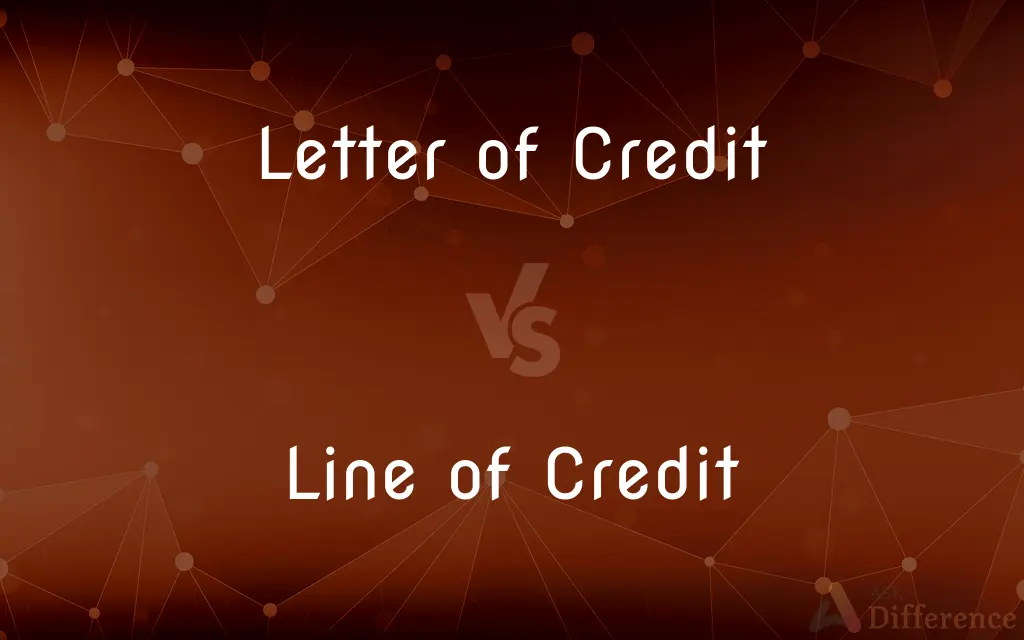Letter of Credit vs. Line of Credit — What's the Difference?
By Tayyaba Rehman — Published on October 28, 2023
A Letter of Credit is a bank's promise to pay a seller on behalf of a buyer, ensuring payment security; a Line of Credit is a flexible loan from a bank, offering a pool of funds a borrower can draw from.

Difference Between Letter of Credit and Line of Credit
Table of Contents
ADVERTISEMENT
Key Differences
A Letter of Credit (LC) serves as an instrument that guarantees payment to a seller on behalf of a buyer. It is primarily used in international trade transactions to ensure that the seller receives payment once specific conditions are met. On the contrary, a Line of Credit (LOC) provides a borrower with access to funds up to a predetermined limit without requiring collateral or a specific repayment schedule.
The application of both financial instruments diverges considerably. A Letter of Credit is mainly utilized in import and export transactions, ensuring sellers that they will be paid once they meet the requirements outlined in the LC. In contrast, a Line of Credit caters to individual or business needs, facilitating short-term capital or covering unexpected expenses, functioning somewhat like a credit card.
Both the Letter of Credit and Line of Credit require a banking institution's involvement. However, while the Letter of Credit assures a seller of payment, acting as a form of payment security, the Line of Credit is essentially a loan facility, permitting borrowers to draw funds as needed, up to the credit limit.
The terms and conditions surrounding these two instruments also differ. A Letter of Credit is usually irrevocable, stipulating detailed terms, such as shipment dates or documentation requirements. In contrast, a Line of Credit typically has more general terms, mainly focusing on interest rates, fees, and the credit limit.
Comparison Chart
Purpose
Ensures payment to seller
Provides flexible loan access to borrower
ADVERTISEMENT
Usage
Primarily in international trade
Personal or business needs
Bank's Role
Guarantor of payment
Lender
Terms & Conditions
Specific to trade conditions
Relates to interest, fees, and credit limit
Flexibility
Fixed based on trade agreement
Highly flexible with revolving access to funds
Compare with Definitions
Letter of Credit
A bank's guarantee of payment to a seller.
The exporter shipped goods, relying on the Letter of Credit for payment assurance.
Line of Credit
Typically unsecured but can be secured.
The homeowner obtained a secured Line of Credit using his property as collateral.
Letter of Credit
Typically irrevocable and assures payment.
The seller trusted the irrevocable Letter of Credit for guaranteed payment.
Line of Credit
Functions similarly to a credit card.
Tom preferred using his Line of Credit over credit cards for major purchases.
Letter of Credit
Used in international trade transactions.
For their international deal, the company secured a Letter of Credit.
Line of Credit
Provides access up to a predetermined limit.
The business had a $50,000 Line of Credit for operational expenses.
Letter of Credit
Protects both buyer and seller in a transaction.
With a Letter of Credit, both parties felt secure in their business deal.
Line of Credit
A flexible loan arrangement with a bank.
Jane used her Line of Credit to cover unexpected medical bills.
Letter of Credit
Contains specific terms and conditions.
The Letter of Credit specified the documents needed for payment processing.
Line of Credit
Interest is charged only on the amount used.
They drew $5,000 from their Line of Credit, incurring interest only on that amount.
Common Curiosities
What is a Letter of Credit?
A Letter of Credit is a bank's assurance to pay a seller on behalf of a buyer, ensuring payment security in trade transactions.
Is a Letter of Credit always irrevocable?
While most are irrevocable, there are also revocable Letters of Credit, but they are less common due to reduced security.
Can a Line of Credit be secured?
Yes, while many Lines of Credit are unsecured, some are secured using collateral like property.
When is a Letter of Credit typically used?
A Letter of Credit is mainly used in international trade to assure sellers of payment once specific conditions are met.
Can an individual get a Line of Credit for personal use?
Yes, individuals can obtain a Line of Credit for personal expenses, much like a credit card.
How does a Line of Credit differ from a Letter of Credit?
A Line of Credit is a flexible loan from a bank to a borrower, while a Letter of Credit guarantees payment to a seller in trade.
Is a Letter of Credit a form of loan?
No, it's a bank's guarantee of payment, ensuring the seller gets paid upon fulfilling certain conditions.
How does interest work with a Line of Credit?
Interest on a Line of Credit is charged only on the amount drawn and not on the entire credit limit.
How long does a Letter of Credit last?
It lasts until the expiration date set within it, which is determined by the agreement between the involved parties.
What happens if I exceed my Line of Credit limit?
Exceeding the limit may result in fees, increased interest rates, or declined transactions.
Share Your Discovery

Previous Comparison
Dominance vs. Codominance
Next Comparison
MDF vs. PlywoodAuthor Spotlight
Written by
Tayyaba RehmanTayyaba Rehman is a distinguished writer, currently serving as a primary contributor to askdifference.com. As a researcher in semantics and etymology, Tayyaba's passion for the complexity of languages and their distinctions has found a perfect home on the platform. Tayyaba delves into the intricacies of language, distinguishing between commonly confused words and phrases, thereby providing clarity for readers worldwide.













































